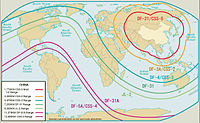CSS-3
| CSS-3 | |
|---|---|
| General Information | |
| Type | ICBM |
| Manufacturer | Plant 211 (Capital Astronautics Co.) |
| development | 1967 |
| Commissioning | 1979 |
| Technical specifications | |
| length | 28.08 m |
| diameter | 2,250 mm |
| Combat weight | 82,000 kg |
| Drive First stage Second stage Third stage |
Liquid rocket engine. Liquid rocket engine. Liquid rocket engine |
| Range | 5,500km-7,000km |
| Furnishing | |
| Target location | INS |
| Warhead | 1 nuclear warhead 1,000 or 3,000 kt |
| Weapon platforms | Stationary on the starting table |
| Lists on the subject | |
The CSS-3 is a land-based ballistic ICBM of the People's Republic of China . In the Chinese armed forces, the rocket is called DF-4 or Dongfeng 4 ( Chinese 东风 , Pinyin Dōngfēng - "east wind").
development
The development of the CSS-3 began in 1967. The system was developed in parallel with the CSS-2 . Many components are used in both rocket models. Both models have the same rocket engine. They are also equipped with the same control and navigation system. Test starts and flight attempts were carried out between 1969 and 1976. In 1979 the first rockets were handed over to the People's Liberation Army . The People's Liberation Army procured 25 to 30 systems.
The CSS-3 formed the basis for the later civilian launch vehicles of the Langer Marsch type .
technology
The missiles are stored in armored silos and are launched directly from them. Some of the missiles are stored in underground bunkers. At the start, the rockets are transported from the bunkers to a launch table and made ready for launch there.
CSS-3 is a two-stage liquid propellant missile. The CSS-3 uses the storable liquid fuels UDMH and nitrogen tetroxide as fuel . It is controlled using an inertial navigation platform . It has a takeoff thrust of 1,224 kN, a takeoff mass of 82,000 kg, a diameter of 2.25 m, a length of 28.05 m and a fin span of 2.74 m. The range of the CSS-3, which is equipped with a nuclear warhead with an explosive force of 3,300 kt and a weight of 2,190 kg, is 4,750 km. A precision ( CEP ) of 1,500 m is achieved.
Due to the relatively poor accuracy of hits, the CSS-3 can only be used against so-called “soft targets” such as population centers, industrial complexes, port facilities and railway junctions. US and NATO experts rate the CSS-3 as an ineffective second-strike weapon .
status
The CSS-3 is now considered technically obsolete. In the People's Liberation Army, the 15–20 CSS-3 systems will be eliminated at the moment and replaced by the DF-31 by 2015 .
swell
- JANE'S STRATEGIC WEAPON SYSTEMS Edition 2003 Jane's Verlag
Web links
Individual evidence
- ^ The Federation of American Scientists & The Natural Resources Defense Council Chinese Nuclear Forces and US Nuclear War Planning p. 202 [1]
- ↑ DF-4 - China Nuclear Forces
- ↑ DF-4 - China Nuclear Forces

